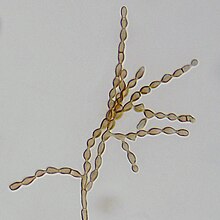Euwallacea interjectus
However, due to increasing trade and globalization, new populations have been found widely in warm regions of the globe.
[1] E. interjectus is found in Myanmar, Japan, North Korea, South Korea, China, Taiwan, Tibet, India, Indonesia (Borneo, Java, Mentawei, Sumatra), Malaysia, Sarawak, Nepal, Philippines, Sri Lanka, Thailand, Vietnam, and recently the United States of America and Argentina.
[1] While it does not appear to be a primary pest on plants, it has been known to be abundant in the U.S., and mass outbreaks on water-stressed boxelder maples have been observed.
[1] Genetic studies provide insight to the spread of E. interjectus to the United States, where three separate introductions took place: Hawaii (1976), Louisiana (1984), and Texas (2011).
[1] E. validus is most present in the northeast United States, however, overlap has been seen around the border of North and South Carolina and around Georgia.
The species has had a detrimental effect on poplars (Populus spp: Salicaceae),[8] which are used for lumber and reconstituted board products.
[10] E. interjectus acts as a vector of Ceratocystis ficicola, a pathogenic fungus that causes wilt disease in fig trees (Ficus carica L.).
Thus, only one female beetle is needed to establish a new population in a new environment,[14] posing a high risk of invasion.
[16] If inbreeding-related abnormalities such as recessive lethal and deleterious alleles are expressed in haploid males, it leads to the death of these individuals.
[14] Euwallacea interjectus exhibits a mutual symbiotic relationship with ambrosia fungi as a nutritional source.
[9] These non-native beetles have entered these various habitats because of human trade as the movement of timber and other tree-based products has acted as vessels for transport.
[17] It has also been seen that the proportion of fungal species that an individual holding and consumption volume shifts over the developmental and maturation period.
In Japan, it was identified that 13 filamentous fungi use E. interjectus as a vector: Fusarium kuroshium, Arthrinium arundinis, Cladosporium cladosporioides, Acremonium sp., Fusarium decemcellulare, Xylariales sp., Pithomyces chartarum, Roussoella sp., Phialophora sp., Stachybotrys longispora, Paecilomyces formosus, Sarocladium implicatum, and Bionectria pityrodes.
[9] Due to the invasive nature of E. interjectus and the damage imposed on trees, they have become a problem for the lumber, pulp, and paper industry.
[8] Their effects on the economy have drawn research attention, to develop insecticides and remedies to prevent damage to plantations around the world.



